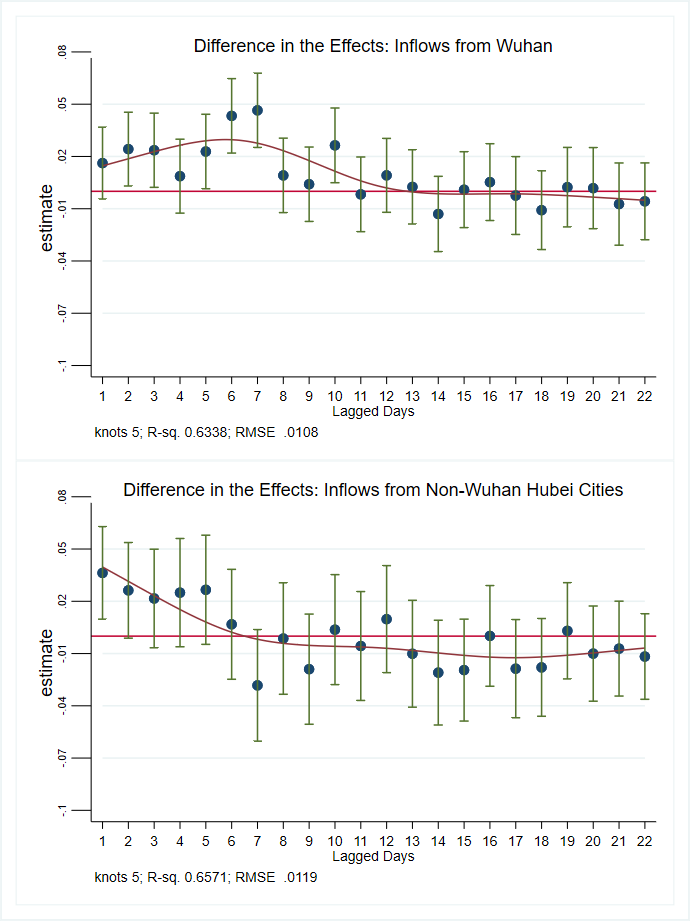Human Mobility Restrictions and the Spread of the Novel Coronavirus (2019-nCoV) in China
We provide a rigorous examination of the causal impact of human mobility restrictions, particularly the lockdown of the city of Wuhan on January 23, 2020, on the containment and delay of the spread of the Novel Coronavirus (2019-nCoV) in China. We employ various difference-in-differences strategies to disentangle the lockdown effect on human mobility reductions from other confounding effects, including a panic effect, a virus deterrence effect, and a Spring Festival effect. We find that the lockdown of Wuhan significantly reduced the within-city movements and cross-city migration with Wuhan, and the enhanced social distancing policies in the 63 Chinese cities outside Hubei province have been effective in containing the spread of the novel coronavirus. We also estimate that, had the government not enacted the historic lockdown of the city of Wuhan, the COVID-19 cases in China would be 64.81% higher in the 347 Chinese cities outside Hubei province, and 52.64% higher in the 16 non-Wuhan cities inside Hubei.

Human mobility contributes to the transmission of infectious diseases that pose serious threats to global health. Indeed, as one of their response plans to pandemic threats, many countries consider and impose measures that restrict human mobility. However, it is empirically challenging to quantify the impact of human mobility on the spread of infectious diseases and to understand the detailed spatial patterns of how infectious disease spreads. Both granular disease occurrence data and human mobility data (Charu et al., 2017) are hard to obtain; moreover, it is difficult to disentangle the impact of human mobility from other potential contributing factors in the spread of epidemics (Ferguson et al., 2006; Hollingsworth et al., 2006). The fast-moving 2019-nCoV and the unprecedented lockdown of 11 million people in Wuhan on January 23, 2020, offer an opportunity to rigorously examine the effects of the city lockdown and understand the relationship between human mobility and virus transmission.
In our recent working paper (Fang et al., 2020), we attempt to examine five related research questions. First, how does the lockdown of the city of Wuhan amid the Novel Coronavirus outbreak affect population movement? Second, how do population flows among Chinese cities, particularly outflows from Wuhan and other cities in Hubei province, affect virus infection in the destination cities? Third, is there evidence and, if so, what is the magnitude of undocumented COVID-19 cases in Wuhan and other cities in Hubei province during the early stages of the epidemic? And, related, how does the extent of undocumented infection cases evolve over time? Fourth, how many COVID-19 cases elsewhere in China were prevented by the unprecedented Wuhan lockdown? Fifth, are social distancing policies in destination cities effective in reducing the spread of infections?
We track the population movement using the intercity and within-city population migration indices from Baidu Migration, which covers 120,142 pairs of cities per day for 364 Chinese cities between January 1 and February 29, 2020, as well as the same lunar dates in 2019. The Baidu Migration data is based on real-time location records for every smartphone using the company’s mapping app, and thus can precisely reflect the population movements between cities. Using the actual population flow data collected by the National Earth System Science Data Center, we convert the mobility index to the number of people.
There are several confounding factors in our attempt to causally quantify the impact of lockdown on human mobility and the spread of infectious viruses. First, the virus outbreak happened right before the Spring Festival of the Chinese Lunar New Year, which causes the largest annual human migration. Second, the virus itself, even in the absence of a mandatory lockdown, may lead to curtailed human movement as people attempt to avoid exposure to the virus in the journeys and public spaces. We refer to this deterrence effect as the virus effect. Third, for Wuhan and other cities in Hubei, there is also the possibility of a panic effect in response to the virus. The panic effect can lead to an increase in the population outflow from the epicenter of the virus outbreak, and a decrease of the population inflow to the epicenter, particularly the city of Wuhan.
To disentangle the pure lockdown effect from the panic effect, the virus effect, and the Spring Festival effect, we exploit the exogenous variations in human mobility created by lockdowns of Chinese cities during the outbreak, and employ several DID estimation strategies by comparing different treatment and control groups. More specifically, the comparison between Wuhan and 284 Chinese cities that were never locked down during the COVID-19 outbreak in 2020 gives general lockdown effects on intercity and within-city population movement. To ensure group comparability, we then compare the population movements of Wuhan in 2020 to the same matched lunar calendar period in 2019. To isolate the lockdown effect from the virus effect, we also compare Wuhan with seven cities (Wenzhou, Zhengzhou, Hangzhou, Zhumadian, Ningbo, Haerbin, and Fuzhou) that went into partial lockdown 12 days after the Wuhan lockdown, between January 1 and February 2, 2020. Moreover, we include two pre-lockdown period indicators in the specification: the period between January 11 and January 19, 2020, is used to examine the parallel trend assumption in the DID analysis, and the period between January 20 and January 22, 2020, or three days before the unprecedented Wuhan lockdown but after the official announcement that the Novel Coronavirus can spread from person to person, is used to capture the panic effect. We also control for the date-fixed effect and compare lunar calendar dates in 2019 and 2020 to eliminate time-specific effects, such as the Spring Festival travel effect.
Based on the DID estimations, we summarize the panic effects, the virus effects, and the lockdown effects on human mobility in the following table:
Table 1. Summarizing the Panic Effect, Virus Effect and Lockdown Effect

We also estimate a dynamic distributed lag regression model by taking into account that inflows from Wuhan with different lags may have differential impacts on the current new cases in the destination cities. The results indicate that the largest impact on the newly confirmed cases today in Chinese cities outside Hubei comes from the inflow population from Wuhan or other cities in Hubei about 12 to 14 days ago. With an assumption that the daily within-Wuhan (Hubei) population movement proxies the “inflows from Wuhan (Hubei) to Wuhan (Hubei),” we estimate the “actual” number of infection cases in Wuhan and other cities in Hubei. We find a persistent gap between the estimated number of infection cases with the actual numbers in Wuhan from the start of the outbreak. As of February 29, 2020, the estimated “actual” number of infections is 11.33% higher than the official reported statistics in Wuhan and is 17.4% higher than the officially reported cumulative cases in 16 other cities in Hubei. Using the results from Table 1, we also show that the COVID-19 cases would be 64.81% higher in 347 cities outside Hubei, and 52.64% higher in 16 other cities in Hubei as of February 29, in the counterfactual world in which the city of Wuhan were not locked down from January 23, 2020.
Lastly, we provide evidence that the enhanced social distancing policies in the destination cities are effective in reducing the impact of population inflows from the source cities of Wuhan and other cities in Hubei on the spread of 2019-nCoV virus in the destination cities. Figure 1 shows the differences in the pre- and post-effects (in terms of destination city’s implementation of social distancing policies) of the lagged inflows from Wuhan (respectively, 16 non-Wuhan cities in Hubei) on the daily new cases in destination cities outside Hubei Province. This, in turn, implies that population inflows from the epicenter contribute more to the spread of infection in the destination cities before they implement social distancing and other control measures. The adoption of extended lockdown measures did play a significant role in flattening the upward trajectory of the virus in the destination cities.
Figure 1. Pre and Post Differences in the Lagged Effects of Wuhan and Non-Wuhan Hubei Cities Inflows on Destination Cities’ Daily New Cases

Our findings demonstrate the role human mobility restrictions can play in containing the spread of contagious disease, and suggest that their imposition can help reduce the number of cases and allow stressed medical systems a better chance to cope with the flood of new cases.
(Hanming Fang, University of Pennsylvania and the National Bureau of Economic Research; Long Wang is an assistant professor in the School of Entrepreneurship and Management at the ShanghaiTech University; Yang Yang is an assistant professor in the CUHK Business School at the Chinese University of Hong Kong.)
References
Charu, V., S. Zeger, J. Gog, O. N. Bjørnstad, S. Kissler, L. Simonsen, B. T. Grenfell, and C. Viboud (2017). Human mobility and the spatial transmission of influenza in the United States. PLoS Computational Biology 13(2), e1005382.
Fang, Hanming, Long Wang and Yang Yang, Human Mobility Restrictions and the Spread of the Novel Coronavirus (2019-nCoV) in China. NBER Working Paper 26906.
Ferguson, N. M., D. A. Cummings, C. Fraser, J. C. Cajka, P. C. Cooley, and D. S. Burke (2006). Strategies for mitigating an influenza pandemic. Nature 442(7101), 448–452.
Hollingsworth, T. D., N. M. Ferguson, and R. M. Anderson (2006). Will travel restrictions control the international spread of pandemic influenza? Nature Medicine 12(5), 497–499.

Latest
Most Popular
- VoxChina Covid-19 Forum (Second Edition): China’s Post-Lockdown Economic Recovery VoxChina, Apr 18, 2020
- China’s Great Housing Boom Kaiji Chen, Yi Wen, Oct 11, 2017
- China’s Joint Venture Policy and the International Transfer of Technology Kun Jiang, Wolfgang Keller, Larry D. Qiu, William Ridley, Feb 06, 2019
- The Dark Side of the Chinese Fiscal Stimulus: Evidence from Local Government Debt Yi Huang, Marco Pagano, Ugo Panizza, Jun 28, 2017
- Wealth Redistribution in the Chinese Stock Market: the Role of Bubbles and Crashes Li An, Jiangze Bian, Dong Lou, Donghui Shi, Jul 01, 2020
- What Is Special about China’s Housing Boom? Edward L. Glaeser, Wei Huang, Yueran Ma, Andrei Shleifer, Jun 20, 2017
- Evaluating Risk across Chinese Housing Markets Yongheng Deng, Joseph Gyourko, Jing Wu, Aug 02, 2017
- Privatization and Productivity in China Yuyu Chen, Mitsuru Igami, Masayuki Sawada, Mo Xiao, Jan 31, 2018
- How did China Move Up the Global Value Chains? Hiau Looi Kee, Heiwai Tang, Aug 30, 2017
- China’s Shadow Banking Sector: Wealth Management Products and Issuing Banks Viral V. Acharya, Jun Qian, Zhishu Yang, Aug 09, 2017




 Facebook
Facebook  Twitter
Twitter  Instagram
Instagram WeChat
WeChat  Email
Email 



